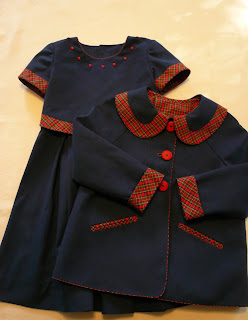I have had several requests for a little picture tutorial of my method for making bound buttonholes. I posted this photo last week on my Facebook page and the Classic Sewing Magazine Facebook page.
It is a close up of a bound buttonhole made with (somewhat enhanced) mini piping using a piping foot on my sewing machine.
The bound buttonholes are featured on this project which will be a new class in 2017. The jacket and dress fabric are cotton twill from Fabric Finders paired with a 100% pima cotton traditional tartan from Spechler/Vogel. The easy fitting raglan sleeve jacket has lots of construction details....bound buttonholes, double welt bias cut front pockets (which look like huge bound buttonholes), bias cut collar overlay, bias cut cuff turnbacks, mini piping on all perimeter edges, and a pleated back with piped tab.
The coordinating dress features a bodice front overlay with a bias cut contrast tartan band, bias cut tartan sleeve overlays, piped back belt with bound buttonholes, and buttons all the way down the back. The hem is bound and shaped to accomodate the A-line of the pleated skirt.
Project kits will be available in several color options - should be something that appeals to everyone.
Here is a picture step-by-step of my methond for making the bound buttonholes.
1. Clearly mark the placement of the buttonhole(s) on the right side of the fabric. For a 1" button (for the jacket) I marked a 1 1/8" buttonhole and for a 1/2" button (back belt on dress) I marked a 5/8" buttonhole. Work over interfaced fabric.
2. Draw in two more lines each an accurate 1/8" away from the center placement line.
3. Make enough piping for the length of each buttonhole plus 1" (x's 2). For this weight of fabric I found using two strands of filler cord instead of one made for a studier, better proportioned bound buttonhole. I did not adjust my needle position as close to the cord as I normally would for single strand piping. Trim the seam allowance down to an accurate 1/8". I checked and it appears none of the piping rulers on the market will cut a seam allowance down to 1/8" so you will have to have a steady hand to make an accurate cut.
4. Cut the piping the length of the buttonhole plus 1". Lay the seamline of the piping on the outer line of the marked buttonhole. The raw edge of the seam allowance should just touch the center marked line. Using your piping foot and adjusting the needle position as necessary to stitch close to the cord, stitch (1.5L) over the seamline on the piping EXACTLY between the two marked vertical edges. Backstitch at the beginning and the end. Repeat for the second strip of piping. The two 1/8" seam allowances should just touch on the center line. I prefer to use the open toe applique foot to make piping on my Pfaff (rather than the mini piping foot). One 'toe' on the foot is exactly 1/4" wide which is super helpful when lining up the strips for the buttonhole. I love my Pfaff - it has 29 needle positions which allows superb accuracy when working with piping.
5. The back should look like this, Slash down the center of the back to within 1/4" at each end. Make a 'Y' cut out to the end of the stitching at each end,
6. Pull the piping strips through to the wrong side. Gently press.
7. Fold the jacket front out of the way and stitch down the little triangle at each end of the buttonhole. Trim the excess piping down to 1/4" at each end of the buttonhole.
8. The following photos show the method I used to finish the lining side of the bound buttonhole. I used silk organza with the lining window 'patch'.






























































